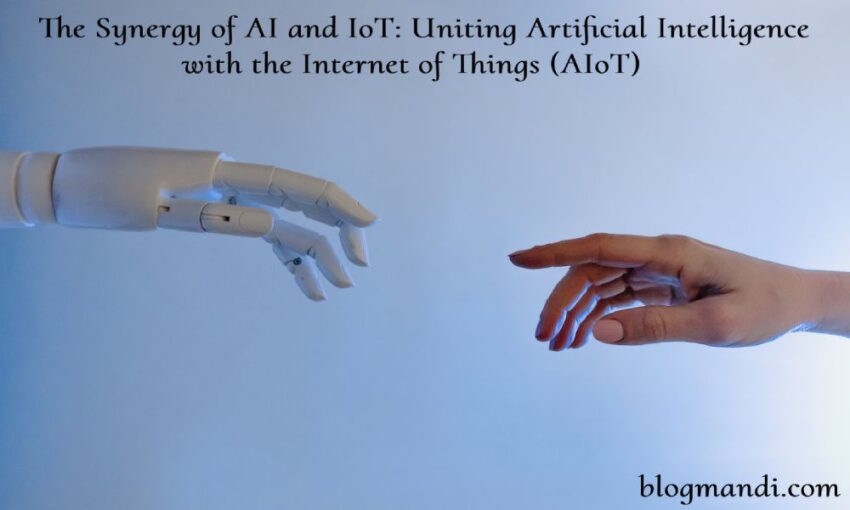Imagine a world where everyday objects seamlessly communicate, make smart decisions, and adapt intelligently to enhance our lives. This remarkable convergence is known as AIoT, where the power of Artificial Intelligence (AI) merges harmoniously with the vast network of the Internet of Things (IoT). In this captivating article, we embark on an enlightening exploration of AIoT, unravelling its immense potential to revolutionize how we interact with technology.
In this article, we’ll delve into the captivating realm of AIoT, uncovering its potential to revolutionize our lives. Join us on this journey as we explore the transformative power of AIoT and its impact on our interconnected world.
Why IoT Needs Big Data?
Think of Industrial IoT as the nervous system of a company. It consists of a network of sensors spread throughout a production plant, gathering valuable information. This data is stored in a central repository for analysis and utilization. The purpose of this network is to measure and collect data, enabling informed decision-making. However, what do we do with all this data? While making good decisions based on reliable information is important, it can sometimes be complicated. In this article, we will explore beyond IoT and concentrate on the data itself, leveraging it through AIoT (Artificial Intelligence of Things) and data analytics.
Big Data and Data Analytics
In recent years, there has been an enormous amount of data generated by digital technologies. This flood of information, known as Big Data, is crucial in the industrial world for achieving success. Big Data refers to the processes we use to examine the data our network of devices captured. The goal is to uncover hidden trends, patterns, or connections that can improve businesses by providing new knowledge.
Big Data has three key aspects: volume (the sheer amount of data), variety (the different types of data), and velocity (how quickly data is captured). These three aspects are often referred to as the 3 V’s. Some definitions also include two additional V’s: veracity (the accuracy and reliability of the data) and value (the benefits the data brings to the business).
Rather than getting caught up in theoretical discussions about what qualifies as Big Data, we believe it’s more practical to focus on the fact that Big Data analysis and processing already apply to a wide range of industries. Thanks to the widespread use of data collection devices, Big Data has become relevant and useful for many businesses.
IoT and Big Data
IoT (Internet of Things) and Big Data are closely connected, with the main connection point being a database. IoT’s primary objective is to collect and organize data, which is then stored in a common repository or database. The role of IoT is to dump the acquired data in an orderly manner into this database. On the other hand, Big Data comes into play when accessing this database to manipulate and analyze the collected data to extract valuable information.
Think of IoT and Big Data Analytics as a toolbox. Different tools from this toolbox are utilised depending on the type of information and knowledge needed from the data. Many of these tools consist of traditional algorithms and enhancements and adaptations of those algorithms based on statistical and algebraic principles. These algorithms have been around for a while. Still, their relevance has increased due to the vast volume of available data and the computing power of modern machines, enabling their application on a larger scale.
However, it is important to note that the current trend in data analysis and Big Data has brought significant innovation to the field. The data ecosystem has expanded and witnessed notable advancements in recent years. One of the fastest-growing areas within this ecosystem is Artificial Intelligence (AI). While AI is not a recent invention, its impact and broad scope make it an integral part of Big Data and Data Analytics. AI is another tool within our metaphorical toolbox, but it has experienced a natural evolution by integrating AI and IoT (AIoT).
AIoT: the Artificial Intelligence of Things
The rapid growth in data volume necessitates innovative approaches to analyze it effectively. In this regard, Artificial Intelligence (AI) emerges as a particularly relevant technology. According to Forbes, IoT and AI are the two dominant trends shaping the technology industry.
IoT and AI are different technologies but significantly impact each other. IoT can be likened to a digital nervous system, while AI acts as the advanced brain that makes decisions to control the overall system. IBM suggests that the true potential of IoT can only be realized through the integration of AI, resulting in AIoT.
So, what exactly is Artificial Intelligence, and how does it differ from conventional algorithms?
Artificial Intelligence pertains to machines that replicate human cognitive functions. It means solving problems similarly to how humans would or finding new ways of understanding data if machines could do it. AI’s strength lies in its ability to generate new algorithms independently, without explicit programming from a human programmer. In essence, Artificial Intelligence, particularly its segment known as Machine Learning, can be seen as algorithms that invent algorithms. Machine Learning is the subset of AI with significant growth and development potential.
Edge AI and Cloud AI
The combination of IoT and AI gives rise to the concept of AIoT (Artificial Intelligence of Things), where intelligent and interconnected systems can make autonomous decisions, evaluate the outcomes, and enhance their performance over time.
There are various ways to integrate IoT and AI, but we would like to highlight two key approaches cloud AI and Edge AI.
- Cloud AI: Centralized data processing in the cloud, offering powerful analysis and collaboration capabilities.
- Edge AI: Autonomous decision-making at the network edge, providing real-time responses and reduced data transmission requirements. The choice depends on application needs, network constraints, and data sensitivity.
Use Cases for Edge AI and Cloud AI
Cloud AI offers comprehensive system analysis and higher-level decision-making capabilities, while Edge AI enables rapid response, autonomy, and localized decision-making.
Example 1: Water control system
- Edge AI detects a leak and blocks a valve for immediate action.
- Cloud AI receives notifications and makes higher-level decisions for alternative water channeling.
Example 2: Smart Grids
- Edge AI analyzes electricity flows and performs local load balancing.
- Cloud AI analyzes data for nationwide energy strategy, enabling regional load balancing and adjustments in electricity production.
The possibilities of AIoT data analytics extend beyond reactive maintenance, including predictive maintenance and macroscopic-level analysis for strategic decision-making in various industries.
End Note
In conclusion, AIoT harnesses the power of both Cloud AI and Edge AI to unlock the full potential of IoT. These technologies enable comprehensive analysis, rapid response, and localized decision-making. With AIoT, organizations can leverage the vast capabilities of IoT services to drive innovation, enhance efficiency, and make data-driven decisions for a wide range of applications and industries.

An author of BlogMandi, We have published more articles focused on blogging, business, lifestyle, digital marketing, social media, web design & development, e-commerce, finance, health, SEO, travel.
For any types of queries, contact us on blogmandi.info@gmail.com

